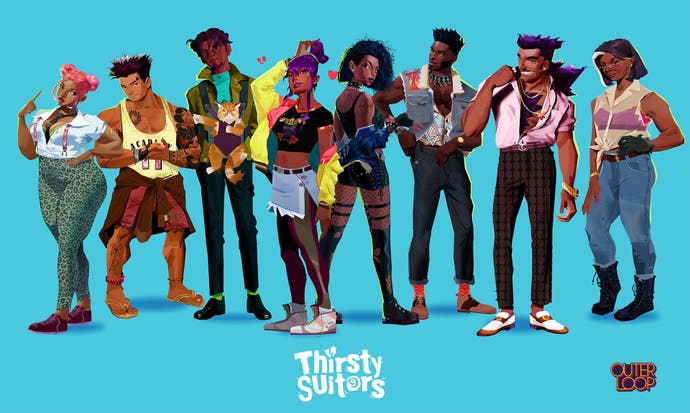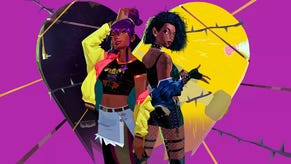Thirsty Suitors is about grinding rails, home cooking and duelling your exes
Heart mode.
Thirsty Suitors is a game about how games can serve as props during difficult conversations - playful tasks that occupy your hands and impose a sense of equilibrium, while you and the other party do the tough work of airing and settling your differences. Created by Falcon Age developer Outerloop, it's a fantastical yet serious account of a queer South Asian immigrant woman reckoning with her cultural heritage, complex family life and torrid relationship history. It does this by means of a blend of gametypes that loosely resembles a traditional RPG, but unlike in most RPGs, each system exists primarily for the sake of the story.
As the tale begins, main character Jala has returned to her old Washington, USA hometown, Timber Hills, to attend her sister's wedding. She's on a journey of self-discovery following a rough break-up, beginning with the personality quiz she daydreams through on the bus - an introduction to both the game's laidback skateboarding, with Jala grinding rails between Qs and As, and her judgy inner narrator, who resembles her sister. But finding herself also means reconciling with her six ex-lovers, all still local and very much Not Over It, to say nothing of her parents, whom she hasn't seen in years. There's also the looming figure of Jala's overseas grandma Paati. She's the unseen hand behind the pop-up paramours you'll have to duel while roaming town, and from the sounds of things, she's the key individual you'll need to wrangle at your sister's wedding.
The game's three main systems offer different ways of rebuilding all those burned bridges. Jala fights turn-based battles with her jilted exes to clear the air, trading wisecracks and barbs about their time together while selecting attacks and abilities. "Defeat" an ex, and you'll gain an acquaintance you can do favours for and perhaps, kindle a fresh romance with. Cooking, meanwhile, is all about bonding with your parents - you follow their instructions to fill up approval metres while trying to find a rapport in dialogue. Skating is tethered to your relationship with your "main" ex, Tyler, but it's also how you'll reconnect with the town of Timber Hills itself, which has sought to reboot itself as a Bavarian tourist dive, after the example of real-life Leavenworth. The old lumberyard has become a themepark, but this has been overrun by rowdy teenagers led by a sinister bear mascot. At Tyler's urging, you enter into boarding duels with the upstart youth to get to the bottom of things.
The battles with exes and suitors are a parade of visual metaphors, the obvious comparison being Edgar Wright's film adaptation of Scott Pilgrim vs The World. Characters swing smartphones by their cables, blow kisses that hit like bullets, and hurl holographic cars at each other. It's a feast for the senses: the music synchs irresistibly to the animations and the colours bang off the screen. The options in combat are straightforward, however: basic melee attacks, special moves that cost Willpower and affect your opponent's Mood (aka status), often softening them up for another kind of attack, and a light sprinkling of QTEs whereby you match a prompt to enhance attacks or block some damage.
The intrigue stems from how these familiar battle concepts perform the game's post-romantic tiffs, in tandem with the snappy writing (the game's narrative designer is 80 Days scribe Meghna Jayanth). When fighting Jala's first love Sergio, a preening gymbody who discos back and forth seductively between rounds, you can flutter your eyelashes to put him in a Thirsty mood, causing him to trip over his own attacks. You can also insult or flirt with him in dialogue to shape the outcome. Escalations in the conversation initiate a second phase that plunges you into your old beau's personal mindscape, where you'll have to brawl with their grander self-delusions. In Sergio's case, his colossal male privilege allows him to shrug off further punishment, forcing Jala to summon her own mother FF-style to belt him with her shoe.


In portraying meetings with old flames as a mock-epic slugfest, there's the risk of making light of actually abusive relationships, but it feels like Thirsty Suitors has dodged this trap, partly because the turn-based approach functions eerily well as a relationship counselling device. It creates breathing room and lets each side have their say. That space to reflect might allow for a scorching putdown, the kind you typically think of days too late. But it can also lead to a kinder, more constructive response. When fighting the overtly ridiculous Sergio, I alternated between shredding him and indulging him, out of sympathy towards the evidently insecure boy beneath the rippling pectorals. In the process, I also started to get a feel for Jala herself and whether she is, in fact, the absolute piece of work described by her estranged lovers and disappointed elders, learning what to expect when I instruct her to cut somebody down to size.
"We get into more dramatic moments, but there's comedy and levity," designer and creative director Chandana "Eka" Ekanayake says. "And we feel like we can go between those things in a relationship game like this, and show it in very fantastical ways. Each of the exes has their own inner worlds, which are how they see their best self and what their world is, and Jala has to navigate that. And yeah, it's tricky. I don't know how many iterations we did on the battle system - we knew was going to be the core of the game, we went through a lot of iteration to find the right fit for this particular game and story. But also, I think it's comfortable enough for folks that have played other turn-based combat games."
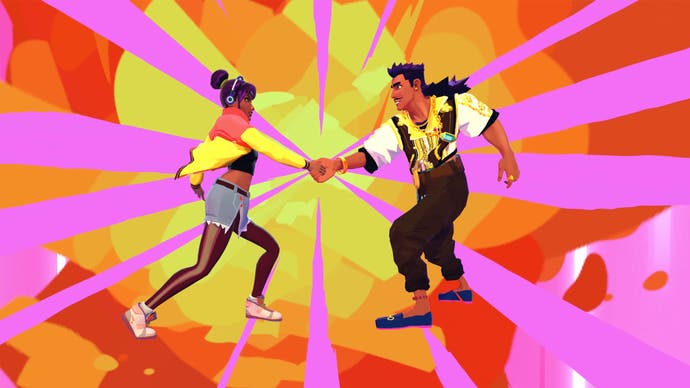
Among the developer's bigger influences is the delightful Paper Mario: The Thousand Year Door, with its literal theatres of battle. "I really liked how that system felt," Ekanayake says. "And we started with that. But then, as we sort of figured out the story, and the characters and sort of the mood system, it definitely went its own way, which we're happy about. It feels like a fresh perspective due to the narrative of the game." The QTE elements recall Paper Mario, too, but the synching of animations and actions to the background music owes more to the rhythm genre. "There's probably elements of, like, Sayonara: Wild Hearts, which I really, really love. But it's a weird, weird mash of things that we did to tell this particular story."
The game's cooking scenes, meanwhile, take huge inspiration from PS1 all-star Parappa The Rappa, both in their bouncy visual presentation and the act of following another character's cues. They're as dreamy and kinetic as the battles, with Jala darting acrobatically around the kitchen as you carry out instructions and pick responses. But where battle is an open confrontation between peers who grew up together, cooking is about carefully reconnecting with an older generation who spent their childhoods on a different continent.
"These are all real recipes," notes Ekanayake. "We have a lot of immigrants on the team, and these are recipes from various cultures. And one of the things we talk a lot about is why cooking is important not just mechanically, but as a way to get your parents to open up a bit. While they're focused on the cooking, they can talk to you, tell you a story - at least, that's been my relationship with my mom, when I'm cooking - I can talk to her about things you would normally not open up about, and we wanted to get that feeling into the game. So while the recipes are real recipes, we don't go through every step - the focus was the emotional beats of that relationship. So while you're doing a step you might get into why Jala broke up with her ex and why she's not been home."
The skating, finally, began life as connective tissue, but is now right at the heart of the proceedings. "When we did the original prototype for this game, we had a loading screen with Jala on a skateboard, kind of shot like a 90s skate video with a fisheye lens and VHS filter," Ekanayake says. "A lot of our playtesters liked the vibe and the feeling of that." Outerloop spent a few months fleshing the idea out, drawing on animator Aung Zaw Oo's passion not just for skating but parkour and martial arts.
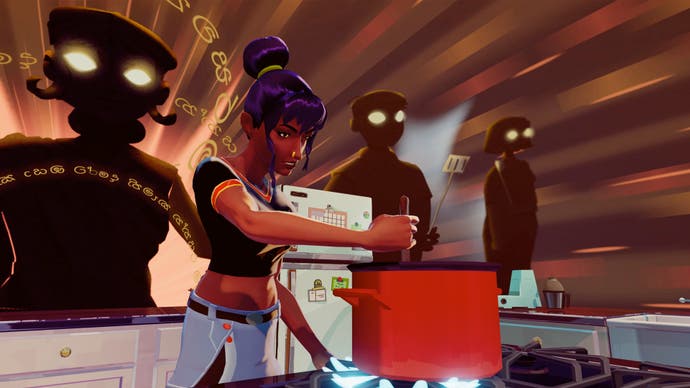
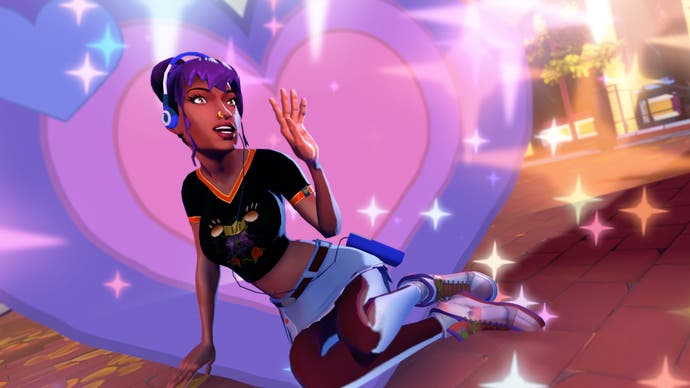
Skating is a test of skill, with multipliers to rack up as you master the various routes created by urban furniture. But it's also easy to get into, with Sonic Adventure-style conveniences such as a quick-turn, and driven far more by reward than punishment. While integral to the plot, it’s also an escape from it - necessary downtime after a brush with a former lover or a tense discussion with mom. "For folks that really want to get deeper into it, there's a whole lot of challenges that we're building out in downtown and the skate park," Aung Zaw Oo observes. "And when you're running around, there's like a combo meter, but you don't ever bail unless you fall in water. It's pretty forgiving if you hit something - we just lower the combo. It's not as difficult as, like, Tony Hawk."
Tony Hawk's skating, Wild Hearts: Sayonara's musicality, Paper Mario's combat - it's easy to portray Thirsty Suitors as an inventively themed album of concepts and influences. There's the risk that all these elements might fly apart in the hands, sabotaging the story's efforts to navigate its messy web of emotional and generational dynamics. I feel like Outerloop is going to pull it all together, though - there's a wonderful, alternately sweet and sardonic energy to the writing and visual presentation, which powers you through the changes of genre. I'm looking forward to playing more of a game which understands that even the most unromantic of RPGs is fundamentally a question of character chemistry.
